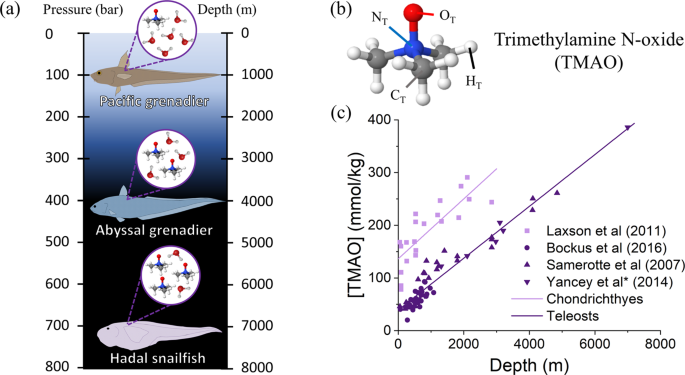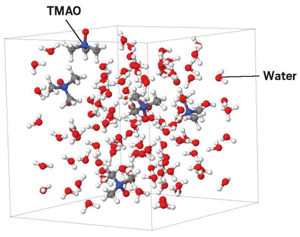The Role of TMAO in Deep-Sea Survival
The deep sea is a realm of perpetual darkness, frigid temperatures, and—perhaps most daunting of all—crushing hydrostatic pressure. For every 10 meters of depth, pressure increases by one atmosphere, reaching more than 1,000 times the surface pressure in the ocean’s deepest trenches. Yet, life thrives in these extreme environments, thanks in part to a remarkable molecule: trimethylamine N-oxide (TMAO).

What Is TMAO?
TMAO is a small organic compound found in the tissues of many marine animals. It is a byproduct of the metabolism of trimethylamine, which is itself derived from the breakdown of certain nutrients.
While TMAO is present in many organisms, its concentration is especially high in deep-sea species.
Trimethylamine N-oxide (TMAO) plays a critical role in enabling deep-sea creatures to survive extreme hydrostatic pressure. Its main functions are:
- Protein Stabilization: TMAO counteracts the destabilizing effects of high pressure on proteins. Under extreme pressure, water molecules are forced into protein structures, causing them to denature and lose function. TMAO stabilizes proteins by preventing water from penetrating and disrupting their structure, thus preserving essential biochemical processes.
- Hydrogen Bond Network Maintenance: TMAO helps maintain the integrity of the hydrogen bonding network in water within cells. At high pressures, hydrogen bonds in water weaken and the structure destabilizes. TMAO acts as an anchor, enhancing hydrogen bonding and restoring water’s structure to a state similar to that at normal pressure, which is crucial for cellular stability.
- Concentration Increases with Depth: The amount of TMAO in marine organisms rises with depth, directly correlating with the increase in environmental pressure. Deep-sea fish can have TMAO concentrations in muscle tissue exceeding 260 mmol/kg, compared to less than 50 mmol/kg in shallow-water species.
- Physiological Importance: Without sufficient TMAO, fish and other marine animals would not be able to survive at depths greater than 5,000 meters due to protein denaturation and cellular dysfunction caused by high pressure
How Does TMAO Help Deep-Sea Creatures Survive?
Protein Stabilization Under Pressure
One of the most significant challenges for deep-sea life is maintaining the structure and function of proteins. High pressure can force water molecules into proteins, causing them to denature (lose their shape) and become nonfunctional. TMAO acts as a chemical chaperone, stabilizing proteins and preventing pressure-induced denaturation. This ensures that crucial biological processes can continue even at extreme depths.
Protecting Cellular Structures
TMAO also helps stabilize cell membranes and other cellular structures. By maintaining the proper balance of water and solutes within cells, TMAO prevents the collapse or malfunction of vital organelles under high pressure.
Enhancing Hydrogen Bonding
The hydrogen bonding network in water is essential for many cellular processes. High pressure can disrupt these bonds, but TMAO helps reinforce them, maintaining the integrity of cellular water and supporting overall cell function.
The Depth-TMAO Connection
Increasing Concentrations with Depth

Studies have shown a direct correlation between the depth at which a marine animal lives and the concentration of TMAO in its tissues. Shallow-water fish have low levels of TMAO, while deep-sea species—such as those found in the Mariana Trench—can have TMAO concentrations more than five times higher. This adaptation is so pronounced that scientists can often estimate the maximum depth a fish can survive based on its TMAO content.
The “Fishy” Smell
TMAO is also responsible for the distinctive odor of some deep-sea fish. When fish are brought to the surface and begin to decompose, bacteria convert TMAO into trimethylamine (TMA), which has a strong, fishy smell.
Limits and Trade-Offs
Osmotic Balance
While TMAO is essential for pressure adaptation, there are limits to how much an organism can accumulate. High concentrations of TMAO can affect the osmotic balance of cells, potentially leading to other physiological challenges. This may help explain why there are few, if any, true vertebrate fish living below about 8,200 meters—the maximum depth at which TMAO can effectively protect proteins without causing other problems.
Conclusion
TMAO is a molecular hero of the deep sea, allowing life to flourish where most organisms would be crushed or rendered nonfunctional. By stabilizing proteins, protecting cellular structures, and maintaining essential chemical balances, TMAO enables deep-sea creatures to survive and thrive in one of Earth’s most extreme environments. Its presence is a testament to the remarkable adaptability of life—and a reminder of the hidden wonders still waiting to be discovered in the ocean’s depths.




